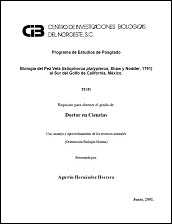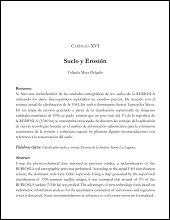Análisis comparativo del metabolismo de purinas en tres especies de mamíferos: acuático (Mirounga angustirostris), semiacuático (Lontra longicaudis annectens) y terrestre (Sus scrofa)
Abstract
Los mamíferos acuáticos y semiacuáticos tienen la capacidad para realizar buceos en apnea (cese de la respiración). El elefante marino del norte (Mirounga angustirostris) puede realizar buceos profundos y de larga duración; en un buceo rutinario puede permanecer en apnea aproximadamente 25 min, y cuando duerme durante su estancia en tierra exhibe apneas de 10 a 15 min. La nutria neotropical (Lontra longicaudis annectens) puede bucear durante 30 seg aproximadamente. Eventualmente, estos períodos de apnea resultan en isquemia (disminución del flujo de sangre oxigenada en tejidos) e hipoxia (disminución de la concentración de oxígeno). La producción de adenosin trifosfato (ATP) requiere de oxígeno, y la mayoría de las especies de mamíferos, como el cerdo doméstico (Sus scrofa) no están adaptadas a tolerar condiciones de hipoxia e isquemia que resultan en degradación de ATP. El objetivo de este trabajo fue explorar si existen diferencias en la actividad de las enzimas y en la concentración de nucleótidos y otras moléculas que intervienen en el metabolismo de purinas en eritrocitos, plasma y músculo de tres especies de mamíferos adaptadas a diferentes ambientes: acuático (elefante marino del norte) (n=11), semiacuático (nutria neotropical) (n=4) y terrestre (cerdo doméstico) (n=11). Se cuantificó, por espectrofotometría y cromatografía, la actividad de las enzimas purina nucleósido fosforilasa (PNP), xantina oxidasa (XO), hipoxantina-guanina fosforribosiltransferasa (HGPRT) e inosina 5’-monofosfato deshidrogenasa (IMPDH), y la concentración de hipoxantina (HX), inosina 5’-monofosfato (IMP), adenosina 5’-monofosfato (AMP), adenosina 5’-difosfato (ADP), adenosina 5’-trifosfato (ATP), guanosina 5’-difosfato (GDP), guanosina 5’-trifosfato (GTP), inosina, adenosina, ácido úrico y nicotinamida adenina dinucleótido (NAD+). Se detectó mayor actividad de las enzimas PNP, HGPRT e IMPDH, así como mayor concentración de HX, IMP, AMP, ADP, ATP, GTP, inosina y NAD+ en eritrocitos y músculo de cerdo doméstico en comparación con elefante marino del norte y nutria neotropical. Estos resultados sugieren que, en condiciones basales (sin buceo, sin apnea del sueño), hay mayor reciclado y síntesis de purinas en el cerdo doméstico, y menor síntesis, degradación, reciclado, y por ende movilización, de purinas en elefante marino del norte y nutria neotropical. Aquatic and semiaquatic mammals have the capacity to perform dives under apneas (breath holding). Northern elephant seals (Mirounga angustirostris) have the ability to perform deep and long duration dives; during a routine dive, adults can hold their breath for 25 min, and when they are sleeping on land they can hold their breaths from 10 to 15 min. Neotropical river otters (Lontra longicaudis annectens) can hold their breath for about 30 sec. Eventually, these periods of apnea result in ischemia (reduced blood supply to tissues) and hypoxia (reduced oxygen concentration). Production of adenosine 5’-triphosphate (ATP) requires oxygen, and most mammalian species, like the domestic pig (Sus scrofa), are not adapted to tolerate hypoxia and ischaemia, both of which result in ATP degradation. The objective of the present study was to explore the differences in enzymatic activity and nucleotide and other molecules concentrations that are involved in purine metabolism, in erythrocytes, plasma and muscle of three mammalian species adapted to different environments: aquatic (northern elephant seal) (n=11), semiaquatic (neotropical river otter) (n=4) and terrestrial (domestic pig) (n=11). Using spectrophotometric and chromatographic techniques, the enzymatic activity of purine nucleoside phosphorylase (PNP), xanthine oxidase (XO), hipoxanthine-guanine phosphoribosyltransferase (HGPRT) and inosine 5’- monophosphate dehydrogenase (IMPDH) was determined. Concentration of hipoxanthine (HX), inosine 5’-monophosphate (IMP), adenosine 5’-monophosphate (AMP), adenosine 5’-diphosphate (ADP), ATP, guanosine 5’-diphosphate (GDP), guanosine 5’-triphosphate (GTP), inosine, adenosine, uric acid and nicotinamide adenine dinucleotide (NAD+) were determined by HPLC. Results showed higher activity of PNP, HGPRT and IMPDH enzymes, and higher concentration of HX, IMP, AMP, ADP, ATP, GTP, inosine and NAD+, in erythrocytes and muscle of domestic pig than tissues of northern elephant seal and neotropical river otter. These results suggest that in basal conditions (without dive or sleep apnea), domestic pig has higher purine synthesis and salvage, while northern elephant seal and neotropical river otter have less purine synthesis, degradation, salvage and therefore, less purine movilization.
Collections
Related items
Showing items related by title, author, creator and subject.
-
PROMOCIÓN DEL PERIFITON PARA EL CULTIVO DE CAMARÓN BLANCO: HACIA UNA ACUICULTURA ECOLÓGICA
DOMENICO VOLTOLINA LOBINA; JUAN MANUEL AUDELO NARANJO; MARIA DEL ROSARIO PACHECO MARGES -
Suelo y Erosión
YOLANDA LOURDES MAYA DELGADO


